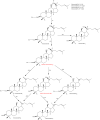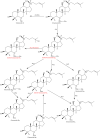Phytochemical analysis of Panax species: a review
- PMID: 33437152
- PMCID: PMC7790905
- DOI: 10.1016/j.jgr.2019.12.009
Phytochemical analysis of Panax species: a review
Abstract
Panax species have gained numerous attentions because of their various biological effects on cardiovascular, kidney, reproductive diseases known for a long time. Recently, advanced analytical methods including thin layer chromatography, high-performance thin layer chromatography, gas chromatography, high-performance liquid chromatography, ultra-high performance liquid chromatography with tandem ultraviolet, diode array detector, evaporative light scattering detector, and mass detector, two-dimensional high-performance liquid chromatography, high speed counter-current chromatography, high speed centrifugal partition chromatography, micellar electrokinetic chromatography, high-performance anion-exchange chromatography, ambient ionization mass spectrometry, molecularly imprinted polymer, enzyme immunoassay, 1H-NMR, and infrared spectroscopy have been used to identify and evaluate chemical constituents in Panax species. Moreover, Soxhlet extraction, heat reflux extraction, ultrasonic extraction, solid phase extraction, microwave-assisted extraction, pressurized liquid extraction, enzyme-assisted extraction, acceleration solvent extraction, matrix solid phase dispersion extraction, and pulsed electric field are discussed. In this review, a total of 219 articles published from 1980 to 2018 are investigated. Panax species including P. notoginseng, P. quinquefolius, sand P. ginseng in the raw and processed forms from different parts, geographical origins, and growing times are studied. Furthermore, the potential biomarkers are screened through the previous articles. It is expected that the review can provide a fundamental for further studies.
Keywords: Analytical methods; Application; Content; Panax species; Sample preparations.
© 2020 The Korean Society of Ginseng. Publishing services by Elsevier B.V.
Conflict of interest statement
All authors declare that they have no conflict of interest.
Figures






Similar articles
-
Forced degradation and impurity profiling: recent trends in analytical perspectives.J Pharm Biomed Anal. 2013 Dec;86:11-35. doi: 10.1016/j.jpba.2013.07.013. Epub 2013 Jul 31. J Pharm Biomed Anal. 2013. PMID: 23969330 Review.
-
Chemical analysis of Panax quinquefolius (North American ginseng): A review.J Chromatogr A. 2015 Dec 24;1426:1-15. doi: 10.1016/j.chroma.2015.11.012. Epub 2015 Nov 14. J Chromatogr A. 2015. PMID: 26643719 Review.
-
Extraction, chemical characterization and biological activity determination of broccoli health promoting compounds.J Chromatogr A. 2013 Oct 25;1313:78-95. doi: 10.1016/j.chroma.2013.07.051. Epub 2013 Jul 16. J Chromatogr A. 2013. PMID: 23899380 Review.
-
Screening of synthetic PDE-5 inhibitors and their analogues as adulterants: analytical techniques and challenges.J Pharm Biomed Anal. 2014 Jan;87:176-90. doi: 10.1016/j.jpba.2013.04.037. Epub 2013 May 6. J Pharm Biomed Anal. 2014. PMID: 23721687 Review.
-
Extraction, isolation, and aromatase inhibitory evaluation of low-polar ginsenosides from Panax ginseng leaves.J Chromatogr A. 2017 Feb 3;1483:20-29. doi: 10.1016/j.chroma.2016.12.068. Epub 2016 Dec 23. J Chromatogr A. 2017. PMID: 28027838
Cited by
-
Comprehensive understanding and underlying molecular mechanisms of the adaptogenic effects of Panax ginseng.J Ginseng Res. 2025 Jul;49(4):356-365. doi: 10.1016/j.jgr.2025.03.013. Epub 2025 Apr 2. J Ginseng Res. 2025. PMID: 40621085 Free PMC article. Review.
-
Panax quinquefolius (North American Ginseng) Polysaccharides as Immunomodulators: Current Research Status and Future Directions.Molecules. 2020 Dec 11;25(24):5854. doi: 10.3390/molecules25245854. Molecules. 2020. PMID: 33322293 Free PMC article. Review.
-
Cultivar Differentiation and Origin Tracing of Panax quinquefolius Using Machine Learning Model-DrivenComparative Metabolomics.Foods. 2025 Apr 14;14(8):1340. doi: 10.3390/foods14081340. Foods. 2025. PMID: 40282742 Free PMC article.
-
Immunomodulatory, Anti-Inflammatory, and Anti-Cancer Properties of Ginseng: A Pharmacological Update.Molecules. 2023 May 3;28(9):3863. doi: 10.3390/molecules28093863. Molecules. 2023. PMID: 37175273 Free PMC article. Review.
-
The integration of spear and shield: a panoramic analysis of the blood circulation-promoting and hemostatic effects of Panax notoginseng.Chin Med. 2025 May 29;20(1):79. doi: 10.1186/s13020-025-01100-6. Chin Med. 2025. PMID: 40442777 Free PMC article. Review.
References
-
- Lu Q. A review on studies of Panax plant taxonomy. J Jilin Agr Univ. 1992;14:107–111.
-
- The State Pharmacopoeia Commission . 2015. Chinese Pharmacopoeia. Beijing.
-
- Ru W., Wang D., Xu Y., He X., Sun Y.E., Qian L., Zhou X., Qin Y. Chemical constituents and bioactivities of Panax ginseng (C. A. Mey.) Drug Discov Ther. 2015;9:23–32. - PubMed
-
- Yang W.Z., Hu Y., Wu W.Y., Ye M., Guo D.A. Saponins in the genus Panax L. (Araliaceae): a systematic review of their chemical diversity. Phytochemistry. 2014;106:7–24. - PubMed
Publication types
LinkOut - more resources
Full Text Sources
Other Literature Sources

